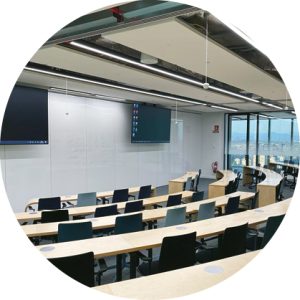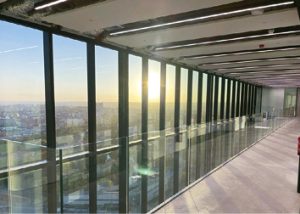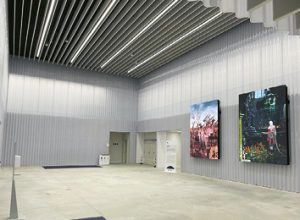 ONE of the tallest skyscrapers in Spain has been recognised for the excellence of its sustainable design after installing a globally proven KNX building automation system reports Paul Jones, B.E.G. Sales Director of UK & Ireland
ONE of the tallest skyscrapers in Spain has been recognised for the excellence of its sustainable design after installing a globally proven KNX building automation system reports Paul Jones, B.E.G. Sales Director of UK & Ireland
Caleido Tower is a 181-metre (594ft) high, 36-storey tower in Madrid, and the seventh tallest building in Spain. The building has met GOLD LEED certification, which means it ‘serves as an exemplary model of sustainability, showcasing the potential for significant environmental impact reduction through thoughtful design and operation’.
The building achieved this by using natural light with the help of an advanced lighting control system by German manufacturer B.E.G. – whose UK headquarters is based in Surrey. Caleido Tower also has facial recognition, intelligently controlled lifts and air filtration and ventilation systems are incorporated.
The project, in the shape of an inverted T, has been divided into four areas: an educational area with 35 floors used by a business school, a wellness clinic, an underground car park, and restaurants and shops.
The technology protocol used in the Caleido Tower was KNX, which brings together multiple systems enabling the uniform networking and visualisation of intelligent devices.
B.E.G. predominately used the PICO sensor – one of the smallest KNX detectors in the world for this project. Despite its diameter of only 33 mm, it has a range for motion detection of 10m transversely, 6m frontally and 4m for seated activities. This means that it detects even the smallest movements, such as the operation of a computer mouse.
In addition to a light output (controllable or switchable) and a slave output for extending the detection range, the B.E.G. PICO also has three Heating, Ventilation and Air Conditioning (HVAC) outputs with which energy-intensive systems such as air-conditioning units can be controlled. The light output can be used both as an occupancy detector and as a twilight detector (motion-independent control/switching).
Since very large ceiling panels were used, it had to be ensured that the respective panel would not sag over time due to the weight of a detector. Weighing only 14g, the B.E.G. PICO proved ideal and was integrated in all rooms where detectors were planned.
With the help of Building Information Modelling (BIM), the building was digitally modelled in advance meaning all alphanumeric properties of the planned building are represented, the data is automatically kept up-to-date, and all parties have access to the status of the project to ensure the different services combine effectively.
The combination of bus systems can help to save energy costs. In the Caleido Tower, over 15,000 DALI (Digital Addressable Lighting Interface) luminaires were installed.
In the corridors of the tower, the light is controlled by the B.E.G. PICO depending on daylight and presence. If no more movement is detected, the orientation light switches on. The lighting is dimmed down to a value of 10 per cent as soon as the room is no longer occupied.
This state remains permanently until the next movement, or the light is switched off after a preset time without detecting movement again. A calendar function can also be used to implement a night mode.
An orientation light is used to visually illuminate the building. The lighting of the IE logo on the façade is automatically switched on in the evening by the B.E.G. KNX switching actuator with a calendar function. Individual luminaires are also switched on and off with switching actuators. This is achieved for example, when illuminating screens for presentations.
With the calendar function, the light is automatically switched off at a preset time in the evenings when there are no more classes and, in addition, no movement is detected in the surrounding areas. This affects the refectory, for example, where the B.E.G. PICO only functions as a twilight detector and only regulates the light to the desired brightness depending on the natural daylight.
The offices and meeting rooms were also equipped with KNX versions of the B.E.G. PICO with push-button interfaces. The detector can be operated in fully automatic or semi-automatic mode. In the fully automatic mode, the light switches on when there is movement, and the brightness falls below the desired value.
For the IE Business School, it was decided to use a semi-automatic mode and a regular mode so that the lighting was regulated to the desired brightness value depending on the daylight. If the amount of daylight increases, the amount of artificial light decreases accordingly and vice versa. If there is enough daylight, the artificial light is switched off despite movement and possibly switched on again later if the level falls below the set value. In addition, the air-conditioning systems are also controlled according to movement to save more energy.
In October 2021, the IE Business School was opened in the Caleido Tower in the presence of Felipe VI, King of Spain, and António Guterres, Secretary General of the United Nations who said the IE Tower is “a symbol of the importance of education, a place of learning, knowledge generation and answers to the challenges of humanity”. That sums up the Caleido Tower and this project perfectly.







